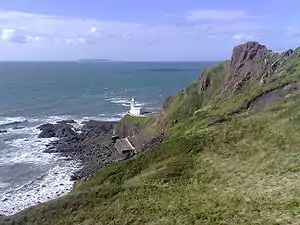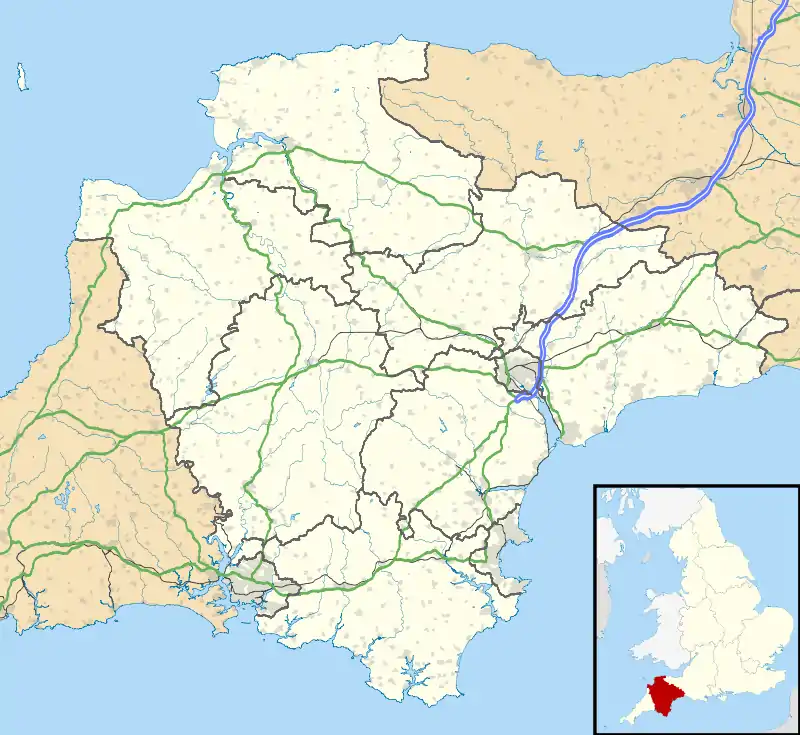Hartland Point Lighthouse
Hartland Point Lighthouse is a Grade II listed building[3] at Hartland Point, Devon, England. The point marks the western limit (on the English side) of the Bristol Channel with the Atlantic Ocean continuing to the west. Trinity House, the lighthouse authority for England and Wales, have a lighthouse on the tip of the peninsula.
 Hartland Point lighthouse. Lundy Island can be seen on the horizon | |
 Devon | |

| |
| Location | Hartland Point Devon England United Kingdom |
|---|---|
| Coordinates | 51°01′19.4″N 04°31′32.6″W |
| Year first constructed | 1874 (first) |
| Year first lit | 2012 (current) |
| Automated | 1984 |
| Deactivated | 2012 (first) |
| Construction | brick tower |
| Tower shape | cylindrical tower with balcony and lantern attached to a 2-storey keeper's house |
| Markings / pattern | white tower and lantern |
| Tower height | 18 m (59 ft) (first) 1.5 m (4.9 ft) (current) |
| Focal height | 37 m (121 ft) (first) 20.5 m (67 ft) (current) |
| Original lens | Bi-form 3rd order 500mm 6 panel rotating |
| Intensity | 635 candela |
| Range | 25 nmi (46 km) (first) 8 nmi (15 km) (current) |
| Characteristic | Fl (6) W15s. |
| Fog signal | blast every 60s. |
| Admiralty number | A5622 |
| NGA number | 6252 |
| ARLHS number | ENG 051 |
| Managing agent | Trinity House[1] [2] |
| Heritage | Grade II listed building |
History

Designed by Sir James Douglass, construction began in November 1873 by contractor Mr Yerward[4] of Wales under the supervision of resident engineer Henry Norris,[5][6] Douglass and Norris having completed Souter Lighthouse in 1871. The tower is 18 metres (59 ft) tall with the lamp being 37 metres (121 ft) above mean sea level. It was blessed by Frederick Temple, Bishop of Exeter, who later became Archbishop of Canterbury, and the light was lit for the first time by Lady Stucley of Hartland Abbey during the opening ceremony on 1 July 1874.[3][6] The optic, a first-order rotating catadioptric array designed by James Chance,[7] had been installed earlier that year.[8] It flashed alternately red and white,[9] the pattern being two white flashes followed by one red flash every thirty seconds.[10] The optic had ruby glass panels mounted over three of its nine lens panels, these panels being around double the width of the other six (to compensate for the loss of intensity of light passing through coloured glass).[11] The light could be seen up to 25 miles (40 km) away from the coast.

The lighthouse was initially provided with a reed fog signal, sounding once every two minutes,[12] which was replaced by a two-tone fog siren later in the 19th century; both installations were powered by caloric engines. In 1911 this was replaced with a new reed horn, and oil engines replaced the caloric ones.[13] The fog signal was sounded from a small building a little to the north-west of the lighthouse.
The lighthouse was built with accommodation for four keepers and their families;[14] it was protected by a 30 metres (98 ft) long sea wall which was built in 1925 to prevent erosion of the rocks on which it stands.[15] The large concrete structures immediately to the south of the lighthouse were to provide the keepers with fresh water.
The light was electrified in 1927,[15] when the optic was replaced by a biform (i.e. two-tier) third-order sextuple-flashing rotating catadioptric optic, designed and built by Chance Brothers; the light had a range of 17 nmi (31 km; 20 mi) and displayed six quick flashes in 7.5 seconds.[16][17] It was lit by two 3 kW filament lamps, one on each tier (the lower lamp was fitted to a turntable lamp changer, which automatically lit a standby lamp (either electric or acetylene) in the event of a bulb or power failure).[18] At the same time a new diaphone fog signal was installed, sounding three blasts every 75 seconds.
In January 1959 the lighthouse was connected to mains electricity; the generator formerly in use was retained for emergency use.[19] Some years afterwards the fog diaphone was replaced with an LIE300 electric horn.[13]
.jpg.webp)
The tower was automated in 1984 and controlled from Trinity House Operations Centre at Harwich in Essex.[20] The keepers' dwellings have since been demolished to make room for a Helipad to be constructed. This was necessary due to the precarious nature of the access road which is liable to frequent rock falls and landslips. Vehicular access is now very difficult and the gates tend to remain locked. The fog signal was discontinued in 2010.[21]
Having carried out a thorough assessment of the requirements for Aids to Navigation off Hartland Point, Trinity House determined that the light at this location could be reduced to a nominal range of 8 nautical miles. This light can be more economically provided by a modern LED beacon in front of the original lighthouse, with no detriment to the safety of the Mariner.[22] Consequently, the old light was decommissioned in 2012.
The Lighthouse was marketed and sold by Trinity House at a £500,000 guide price, consisting of "the former lighthouse, three bedroom living accommodation over two storeys, various stores, a helipad and access via a surfaced road that leads up the cliff to the gated entrance. The site in total amounts to about 16 acres of cliff and coastline, and has the best sea views in the area."[23]
References
- Hartland Point The Lighthouse Directory. University of North Carolina at Chapel Hill. Retrieved 1 May 2016
- Hartland Point Lighthous Trinity House. Retrieved 1 May 2016
- Historic England. "Hartland Point Lighthouse (1309148)". National Heritage List for England. Retrieved 31 July 2010.
- "Hartland", Exeter Flying Post, p. 7, 2 August 1871,
It is now announced...that Mr. Levy Yerward, late Government contractor at Pembroke Dock, has been selected by the Trinity Board to erect a lighthouse, dwelling houses, and other buildings at Hartland Point.
- "Hartland", Exeter and Plymouth Gazette, p. 7, 18 April 1874,
Hartland Point Lighthouse - Since the latter part of November, when the foundation stone of this work was laid, and the rough weather soon after set in, the building has been suspended and only a few hands partially employed on the works. We are happy to note the return to business this week of Mr. Ferward, the contractor, and Mr. Norris, the engineer of the works.
- "Hartland - Opening of the Lighthouse", Exeter and Plymouth Gazette, p. 7, 3 July 1874
- "Sir James Chance, Bart. [obituary]". The Engineer. 93: 44. 10 January 1902.
- "Photo of the optic (with its front red panels removed)" (PDF). Trinity House. Retrieved 13 March 2019.
- Davenport Adams, W. H. (1891). The Story of our Lighthouses and Lightships: Descriptive and Historical (PDF). London, Edinburgh & New York: Thomas Nelson & Sons. p. 253. Retrieved 27 February 2019.
- The Nautical Magazine for 1874 (volume XLIII). London: Simpkin, Marshall & co. 1874. p. 432.
- Littell, Eliakim; Littell, Robert S. (1887). Littell's Living Age (Volume 174). London: T.H. Carter & Company. p. 247.
- "Fog Signals". Parliamentary Papers, Volume LXIV. 23 (337): 2–4. 1 August 1879.
- Renton, Alan (2001). Lost Sounds: The Story of Coast Fog Signals. Caithness, Scotland: Whittles. p. 96.
- "Photo". Trinity House. Retrieved 21 March 2019.
- "Hartland Point Lighthouse". Trinity House. Archived from the original on 9 August 2009. Retrieved 31 July 2010.
- Cooper, F. W. (1979). Twenty Years in Lighthouses (PDF). United States Lighthouse Society. pp. 10–14. Retrieved 13 March 2019.
- "Photo". Shipping Wonders of the World (3). 27 February 1936. Retrieved 21 March 2019.
- "Coastal Warnings to Mariners that Interest the Holiday Visitor". The Illustrated London News. 183: 315. 26 August 1933.
- "Mains Electricity at Hartland Lighthouse". Bideford and District Community Archive. Retrieved 28 May 2019.
- "Hartland Point Lighthouse". Photographers Resource. Retrieved 31 July 2010.
- "Hartland Point Lighthouse". Worldwide Lighthouses. Retrieved 21 March 2019.
- "Hartland Point Lighthouse". Trinity House website. Archived from the original on 22 February 2014. Retrieved 1 November 2011.
- "Hartland Point Lighthouse, North Devon - Archive - Trinity House". Trinity House website. Archived from the original on 11 June 2012. Retrieved 26 July 2012.